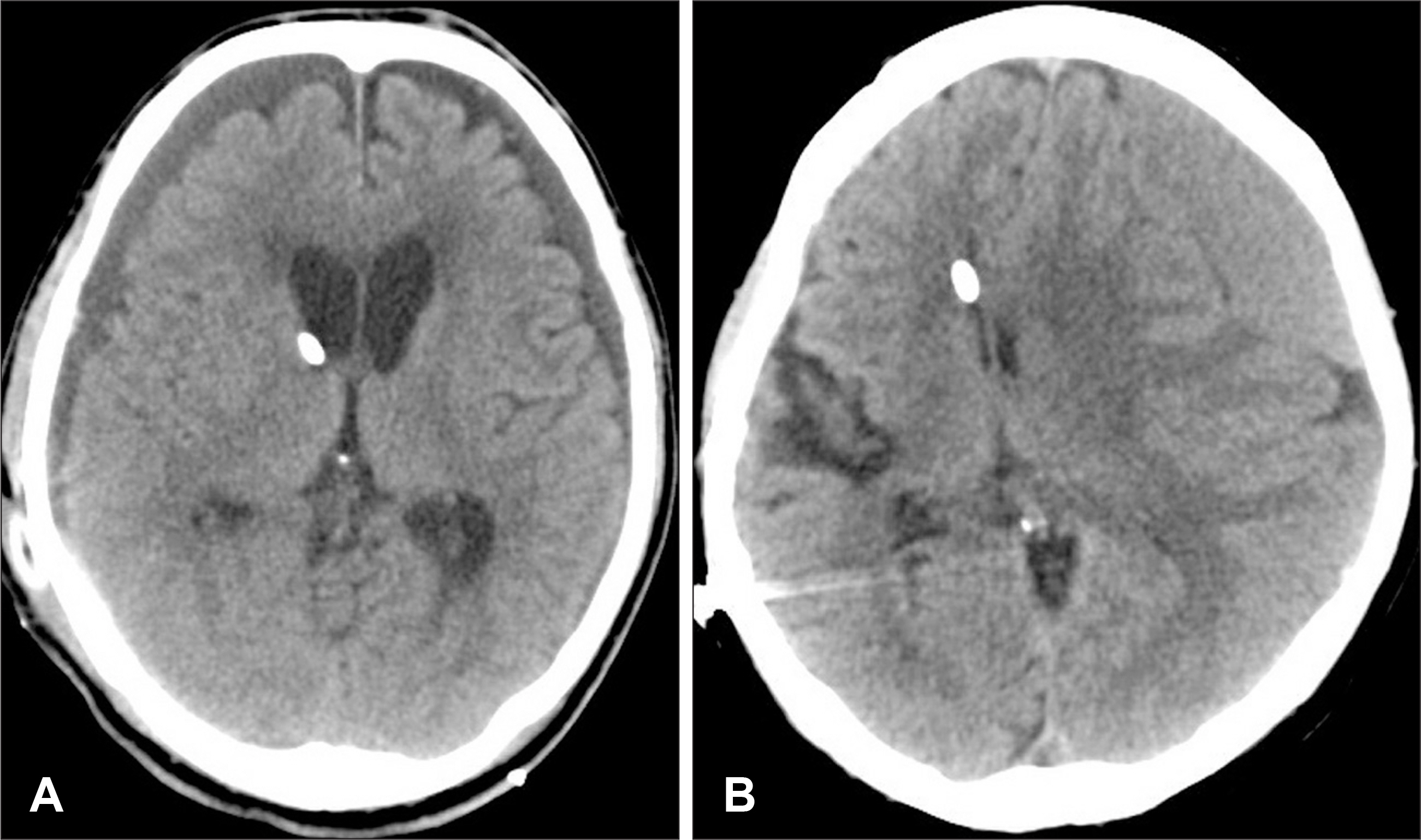Korean J Neurotrauma.
2012 Oct;8(2):68-72. 10.13004/kjnt.2012.8.2.68.
Clinical Analysis of Subdural Hematoma after Ventriculoperitoneal Shunt for Hydrocephalus
- Affiliations
-
- 1Department of Neurosurgery, Catholic University of Daegu College of Medicine, Daegu Catholic University Medical Center, Daegu, Korea. fhjhcho@yahoo.co.kr
- KMID: 1427708
- DOI: http://doi.org/10.13004/kjnt.2012.8.2.68
Abstract
OBJECTIVE
Subdural hematoma is one of complications of ventriculoperitoneal (VP) shunt for hydrocephalus. We observed many cases of subdural hematoma on early post-operative computed tomography scan performed after VP shunt. We analyzed clinical features and factors related occurrence of subdural hematoma after VP shunt.
METHODS
From January 2009 to December 2011, 104 patients underwent shunt surgery by programmable valve for hydrocephalus. The demographic factors, preoperative medications, causes of hydrocephalus, radiologic features, and operative findings were reviewed. We divided patients into two groups: occurrence of subdural hematoma (Group A) and no evidence of subdural hematoma (Group B).
RESULTS
Fifty-eight patients (55.8%) had a subdural hematoma after VP shunt. Mean setting pressure of valve was higher in group B compared to group A. A setting pressure is the only factor related to occurrence of subdural hematoma. Five patients in Group A (8.6%) had symptoms of subdural hematoma. Though subdural hematoma was absorbed spontaneously or by increasing of setting pressure of valve in majority of Group A, five patients underwent additional operation.
CONCLUSION
The setting pressure of valve was important to prevent and treat subdural hematoma after VP shunt for hydrocephalus.
Figure
Reference
-
1). Becker DP., Nulsen FE. Control of hydrocephalus by valve-regulated venous shunt: avoidance of complications in prolonged shunt maintenance. J Neurosurg. 28:215–226. 1968.
Article2). Benzel EC., Pelletier AL., Levy PG. Communicating hydrocephalus in adults: prediction of outcome after ventricular shunting procedures. Neurosurgery. 26:655–660. 1990.
Article3). Black PM. Idiopathic normal-pressure hydrocephalus. Results of shunting in 62 patients. J Neurosurg. 52:371–377. 1980.4). Black PM., Hakim R., Bailey NO. The use of the Codman-Medos Programmable Hakim valve in the management of patients with hydrocephalus: illustrative cases.: 1110-1113. 1994.5). Boon AJ., Tans JT., Delwel EJ., Egeler-Peerdeman SM., Hanlo PW., Wurzer HA, et al. Dutch Normal-Pressure Hydrocephalus Study: randomized comparison of low- and medium-pressure shunts. J Neurosurg. 88:490–495. 1998.
Article6). Chrissicopoulos C., Mourgela S., Kirgiannis K., Sakellaropoulos A., Ampertos N., Petritsis K, et al. What is the appropriate shunt system for normal pressure hydrocephalus? Acta Neurochir Suppl. 113:119–121. 2012.
Article7). Dietrich U., Lumenta C., Sprick C., Majewski B. Subdural hematoma in a case of hydrocephalus and macrocrania. Experience with a pressure-adjustable valve. Childs Nerv Syst. 3:242–244. 1987.8). Fukuhara T., Vorster SJ., Luciano MG. Critical shunt-induced subdural hematoma treated with combined pressure-programmable valve implantation and endoscopic third ventriculostomy. Pediatr Neurosurg. 33:37–42. 2000.
Article9). Illingworth RD. Subdural haematoma after the treatment of chronic hydrocephalus by ventriculocaval shunts. J Neurol Neurosurg Psychiatry. 33:95–99. 1970.
Article10). Kamikawa S., Kuwamura K., Fujita A., Ohta K., Eguchi T., Tamaki N. [The management of slit-like ventricle with the Medos programmable Hakim valve and the ventriculofiberscope]. No Shinkei Geka. 26:349–356. 1998.11). Kurschel S., Puget S., Bourgeois M., Zerah M., Ofner P., Renier D. Factors influencing the complication rate of subduroperitoneal shunt placement for the treatment of subdural hematomas in infants. J Neurosurg 106(3 Suppl): 172-178. 2007.
Article12). Kuurne T., Servo A., Porras M. Subdural effusions re-appearing after shunts in patients with non-tumoural stenosis of the aqueduct. Acta Neurochir (Wien). 67:127–134. 1983.
Article13). Lee MC., Lee JK., Kim JH., Kim HW., Kim TS., Jung S, et al. Effectiveness of the Medos Hakim Programmable Valve in the treatment of various type of hydrocephalus. J Korean Neurosurg Soc. 28:1714–1720. 1999.14). Puca A., Fernandez E., Colosimo C., Lauretti L., Pallini R., Tamburrini G. Hydrocephalus and macrocrania: surgical or non-surgical treatment of postshunting subdural hematoma? Surg Neurol. 45:376–382. 1996.
Article15). Pudenz RH., Foltz EL. Hydrocephalus: overdrainage by ventricular shunts. A review and recommendations. Surg Neurol. 35:200–212. 1991.
Article16). Samuelson S., Long DM., Chou SN. Subdural hematoma as a complication of shunting procedures for normal pressure hydrocephalus. J Neurosurg. 37:548–551. 1972.
Article17). Sternbach GL. Subdural hematoma in a shunted patient. J Emerg Med. 29:483–484. 2005.
Article18). Yamashita N., Kamiya K., Yamada K. Experience with a programmable valve shunt system. J Neurosurg. 91:26–31. 1999.
Article
- Full Text Links
- Actions
-
Cited
- CITED
-
- Close
- Share
- Similar articles
-
- Clinical Experience on Lumboperitoneal Shunt
- A Case of Acute Epidural Hematoma after 4 months of Ventriculo-Peritoneal Shunt
- "Syndrome of the Sinking Skin-Flap" Secondary to the Ventriculoperitoneal Shunt after Craniectomy
- Spontaneous Resolution of Chronic Subdural Hematoma in Children: Case Report
- Isolated Lateral Ventricle after V-P Shunt


